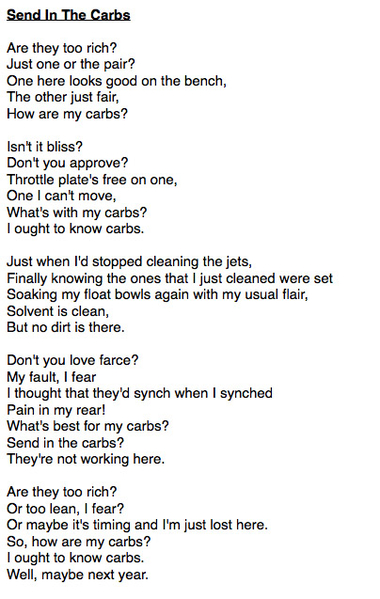OK, I'll take Pat's 'no' on the 3.0 as a definitive don't do it. Thanks Pat for putting that question to bed!
To answer a couple of questions quick: The cam is W110, which (yeah I know) I outgrew a lot of modifications ago. Still, it seems to pull to 6000 which is more sensory overload than I ever need and never exceed (on purpose). If I ever split the case again, I'll change it, just because . . .
As mentioned, the fuel pump is a Carter. The regulator is Malpasi, with verified adjustment to 2.5 static pressure. The rubber fuel lines are all 3/8 ID. 3/8 OD stainless tubing makes the fuel line run from front to back and presents the most restrictive hole in the chain: .30". The stainless fuel tanks are custom, with basically a 3/8 ID hose in the tank attached to a 3/8 OD nipple out of the tank.
Altogether, I am pretty sure I have plenty of fuel delivery to the carbs. I've proven this to myself several times over the years by disconnecting the fuel line from the carb intake banjo and running the pump to fill a quart jar. There is no way I could use gas as fast as I can fill a quart jar; if I could, I'd run out of gas between gas stations.
All of this is what led me to the question about the fuel inlet/needle valve size, since that is the most restrictive hole in the supply between fuel tank and float bowl. And, until last week I didn't know they came in different sizes.
But after Pat's reply (and Gordon's questions), I'm starting to rethink everything. I've always thought I was running out of gas. But what if it was the opposite, what if I was flooding too much gas!? Apparently that's possible, according to Pat.
So off to the garage I went, and rummaged for the baggie marked "used Dellorto parts". In it I found both carb's fuel inlets that I replaced more than 15 years ago when I first rebuilt the carbs. Out of curiosity I found that a 1.19mm drill bit was very loose in the inlet hole, and a 2.38mm wouldn't fit. So there is a good chance the inlets I removed way back then are actually 2.00mm. And since the inlets that are now installed have a hole bigger than 2.38mm and smaller than 2.79mm, I'm betting the inlets are like 2.50mm. Not knowing any better, I guess I replaced the 2.00 inlets back then with 2.50.
Well, if 3.00 is an assured flood-a-rama, is 2.50 also too big?
So here is what happens behind the wheel: First of all, I have to be 'trying' hard to make it happen, ae, thrashing it. And since I know it might happen when thrashing it and for other common sense reasons I don't go thrashing often. I never notice the problem in normal 2000-4000 rpm driving.
What happens when thrashing is it starts cutting out as it begins loosing cylinder(s) within a minute or so of hard throttle pumping up and down shifts basically all over 4000 rpm. The remedy is to let it work itself out while idling along side the road or slow rpm driving. This may take a few minutes, not a matter of seconds (to answer your question Gordon). Eventually the engine smooths out and everything is OK again.
Can it be that instead of running out of gas in the float bowl as I've been suspecting, is in reality that I am flooding it with too much gas and temporarily fouling the plugs? And, once they've had a chance to 'dry out' by puttering alongside the road, I'm good-to-go again?





